This young couple were your typical urban homesteaders - until they adopted two pigs. It all snowballed from there.
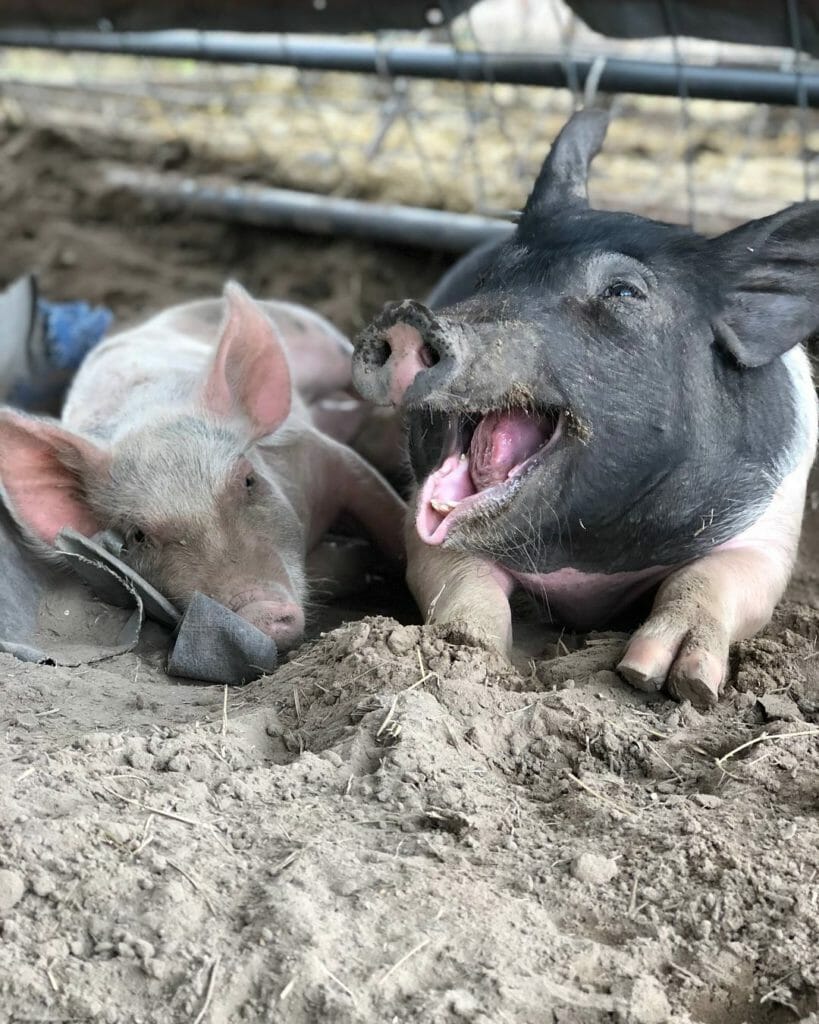
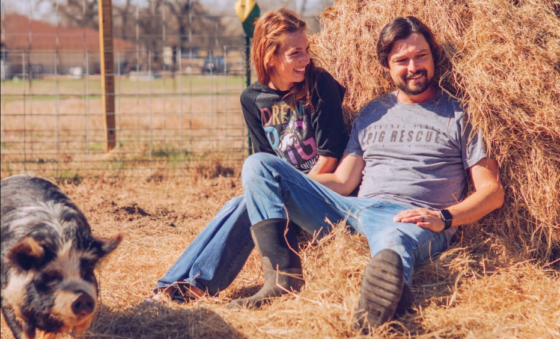
Brittany and Dan Illescas, founders of Central Texas Pig Rescue (CTPR)
in Bastrop, Texas, just outside of Austin. / Matt Bradford
In little more than two years since buying a more sprawling, three-acre rural property in Bastrop, Texas – just 30 minutes east of Austin – in February 2016. Exactly one year later, the Illescases’ launched their non-profit and quickly grew it to become one of the country’s most well-known livestock rescues and sanctuaries, now with more than 200 pigs, nine chickens, four donkeys, three goats, six cats, two Guinea fowl, a toad named Frank Reynolds, and 22,700 fans on Instagram.
From the moment Brittany, 34, and Dan, 37, started using social media to spread the message about the myth of “mini pigs”, “micro pigs,” and “teacup pigs” – all of which are nothing more than starved and malnourished normal-size pigs – the Illescases have been fully immersed in the pig community and have become highly visible advocates for farm animal welfare and education. They’ve found purpose in researching and providing resources for “real life with pigs” – everything from pig behavioral training and advice for pig owners and farmers, to helping veterinarians become more comfortable treating pigs, both physically and mentally, shifting their mindset to look at the animals (and their treatment protocols) as pets and not just meat.
We sat down with them a few weeks ago on their Texas porch, on the 100-degree eve of the biggest cruelty seizure intake they’d ever had – piglets encircling and snuggling up to our ankles – to get our facts straight about pig rescue and pig wellness.
MF: How did a girl from Minnesota and a guy from the West Coast end up raising pigs?
Brittany: We’d always adopted and fostered dogs, and after moving to Austin we decided that we wanted to adopt a pig for our little backyard farm. It felt wrong to buy from a breeder, so we did a ton of research – Dan is a researcher, he took two months just to decide on a toaster (which we still have). Despite all that, bringing Eleanor home was still like bringing home a human baby: We realized we knew nothing. We knew full well that Eleanor would not stay small, and we knew that pigs got bigger than breeders said, but we didn’t realize the extent of the trickery and lies pet pig breeders use to deceive people. Because we got her from a small rescue situation outside Luling, Texas, we saw Eleanor’s very large mama and knew that she could easily be that big. She was eight weeks old and intact, but vets still wouldn’t see her. We were big dog training dorks, but she showed behaviors that we really didn’t understand. And then we adopted our second pig, Franklin. When we got him from Craigslist, he’d already had a few homes and was being sold as “35 pounds full grown” (he now weighs 110 pounds). So after that, as we walked our “suburban mini pigs,” as they’d been billed, around the neighborhood, we carried educational cards with their photo and our Instagram handle to hand out – we’d just started our push for pig education and were posting a lot [on Instagram] about how challenging pigs are, the lies breeders sell, and how big they really do get. Basically, we would walk around and tell people, “Enjoy these guys, but please don’t get your own.”
“Only 3% to 10% of people who purchase a pet pig keep it. The rest end up abandoned, in shelters, on Craigslist, or worse.”
MF: Was sharing all of your research the start of your role as a pig advice service?
Brittany: The more we got involved, the more we realized that a lot of the people in the pig-raising community were living our story in parallel but no one was talking about it. The reality and the research are so different, so there’s guilt and there’s shame and so no one’s passing on the knowledge to help the next person down the line. Nearly everyone who gets pigs as pets soon realizes that the reality and the research for pig ownership are vastly different – there’s not much out there at all about owning and raising pigs other than for meat, and what is out there comes from “mini pig” breeders themselves and can’t be trusted. We want to break that chain and that cycle. The lack of education is the main reason people get rid of their pet pigs just as quickly as they can get them: Only 3% to 10% of people who purchase a pet pig keep it. The rest end up abandoned, in shelters, on Craigslist, or worse. We want to change that.
Our first three pigs – Eleanor, Franklin, and Annie – are all potbellied pigs. Eleanor is a classic Vietnamese Potbelly and the other two are likely just mixes. There are no regulations or guidelines for breeding pet pigs, so everything is kind of mix and match at this point and just called “potbellies.” There are very few recognized “mini” pig breeds, but KuneKunes, Guinea Hogs, Ossabaw Island Hogs, and Meishan Pigs are technically “mini” pigs since they are less than the 300- to 400-pound classification that denotes a “mini” pig, but those breeds all originated as meat pig breeds, not pets. The first potbellied pigs came to America in the 1980s, but even they aren’t really a specific breed, more of a type of pig with several variations. Juliana Pigs, American Miniature Pot Bellied Pigs, Mini Pot Bellied Pigs, Pocket Pigs, Micro Pigs, Teacup Pigs, Dandy Pigs, Painted Pigs, and so on are NOT breeds, they’re just marketing terms invented by breeders and not actually recognized or standardized. Some of these fake breeds even have registries created by the breeders themselves to make them seem more legitimate.
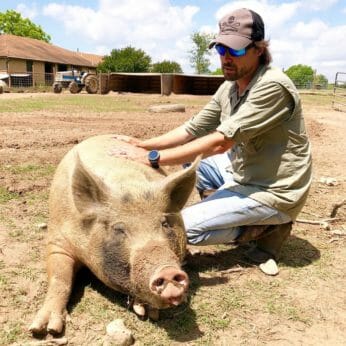
Dan Illescas hanging out at CTPR with one of the pigs on Father’s Day 2018. Photos by Brittany & Dan Illescas/Central Texas Pig Rescue
MF: So, naturally, you launched a pig rescue.
Brittany: Our family motto is “We Don’t Fuck Around.” Within six months of moving to Austin, we had all these animals. Within two months of deciding to start a pig rescue, we had a pig rescue. After we adopted Eleanor and Franklin, Dan realized that there were 75 to 85 piglets being sold on Craigslist in Texas alone at any given time, so he started flagging each one for the Craigslist monitors. I was still working my main job as a manager with Anthropologie stores, and it was the holiday season, so I was getting home at 1 a.m. and trying to avoid the anxiety of all of that…until we saw Annie on Craigslist, a one year old so-called “teacup pig” who was smaller than a shoebox. Annie was the full catalyst for the rescue. The breeder told Annie’s previous owners to feed her two tablespoons of food per day and a Flintstone vitamin – or the equivalent of one 50 pound bag of feed in a year. She was living in a dog crate with a hamster feeder because she kept tipping her water bowl over. When she got excited, she’d slam herself into the side of her crate and she could barely stand up straight. She’d never been to the vet, she’d never been outside because they said that it scared her, so they got bored of her and she became a terror – she’d literally lunge at you like a little T-Rex when she went into heat. They weren’t bad people, they just wholeheartedly believed the lies the breeder told them and followed her feeding and care instructions exactly. As a result, Annie suffered tremendously but they thought she was cute and tiny and couldn’t see they were harming her. After rescuing Annie and watching her get healthy we decided that we wanted to do as much as we could to stop that from happening to another pig. We just looked at each other and knew we couldn’t allow this to continue. If you’re thinking of adding a pig to your family, read our pretty thorough FAQs on the CTPR website first.
MF: Who did you look to for expertise and mentorship, and where did you find guidance?
Dan: There’s just so little information out there: breeder websites are a masterpiece of lies, and there are no protections for livestock animals, not even as pets. The 100+ pigs that recently came to us from the Caldwell cruelty seizure were confiscated because of the dog on the property: animal cruelty officers know what to look for in signs of animal cruelty and abuse for horses, dogs, or cats, but they look at the pigs and think they’re fine because they don’t know what to look for. We’re self-taught dog training enthusiasts who watch a lot of Victoria Stilwell videos, and had a lot of previous foster and rescue dog experience, so we tried to apply that to pig rescue by using a lot of trial and error. Now, when we go to help other people with their pigs it looks like magic, but all we do is pay attention to what the pigs were trying to tell us and react appropriately.
MF: How else does pig behavior differ from other farm animals and pets, like dogs?
Dan: Unlike dogs, where there’s a pack leader and then everyone else below, pigs have a ladder-like hierarchy with just one rung for each pig in a defined order. Pigs might scuffle when they first meet, but the order takes over. They’re herd animals and do best with a pig friend for companionship to prevent boredom and loneliness, but they can still be very demanding pets that require a lot of attention. In the right circumstances, though, they can make wonderful companions. We started the rescue because people will adjust their lifestyle but only so much, and then lifestyles change and they can no longer factor a pig into their life. A lot of pigs are given up because they seem “aggressive,” say toward a three-year-old child, but you need to learn how to talk pig and show your kid how to talk pig. If that kid is running around with food in front of the pig, you’re setting the pig up to fail.
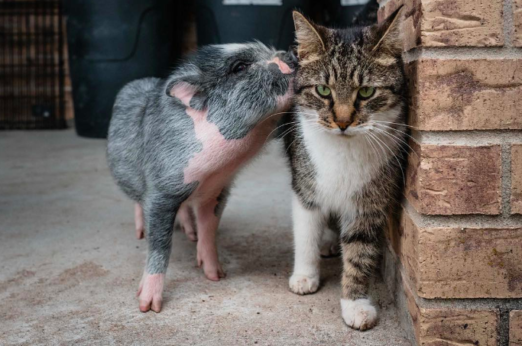
Mordechai the piglet and Dark the farmhouse cat caught sharing secrets / Aleks Gajdeczka.
MR: Where do most of your pigs and other rescued farm animals come from?
Brittany: We get large numbers of animals all at once from cruelty seizures, like our recent Caldwell pigs intake, but we also get calls every month from families who realize that their pet pigs got a lot bigger and were a lot more challenging than their breeder led them to believe: they’re not “just like dogs.” We also get a lot of calls from Future Farmers of America families who are shocked that their kid’s beloved animal, which they raised for a year, is going to be sent off to the slaughterhouse. They’re perplexed because it’s a rite of passage in changing times, they didn’t do any research and their expectations weren’t set, they live in the suburbs and the animal has been living in a show barn where they’ve been paying its rent. They aren’t prepared to care for a pig that costs $100 a month to feed and that will live for 15 to 20 years. Everyone thinks there’s a magical farm upstate where all the animals go. These programs, including school children raising chicks in a classroom, aren’t teaching responsibility. They just teach kids to pass the buck, to raise something for a set period of time and then expect that it’s okay for it to become someone else’s problem. And it’s not at all sustainable for us to take in every farm animal that someone wants to save from its traditional fate.
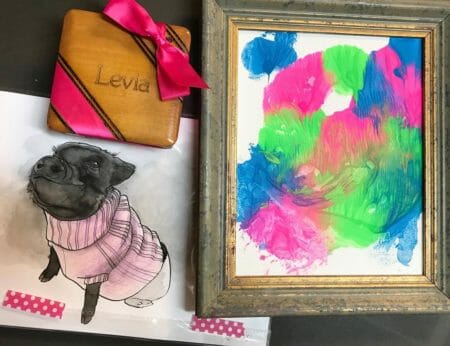
Snout art and fan art of a beloved CTPR piglet named Levia Rose, whose story of survival captivated fans and whose passing shook the community. Photos by Brittany & Dan Illescas/Central Texas Pig Rescue
MR: Is that why your growth revolves more around outreach than numbers of animals?
Brittany: In order to focus more of our efforts on our educational, rehabilitation, and advocacy components, we’re currently in the process of purchasing a second 5- to 15-acre property nearby, and we joined forces with Misfits of Oz farm animal sanctuary founder Shanda Harris, who just moved her entire operation from Kansas to Texas to oversee CTPR’s growing number of sanctuary animals who cannot be rehomed due to neglect, abuse, or cruelty. About 60% of our pigs (the healthy but unsocialized, not highly adoptable pigs) will move there with Shanda and be housed in very large 0.5- to 1-acre group pens. The remaining pigs will stay at the original property, which will become home to all the adoptable, highly social, and special needs pigs who allow us to still offer tours and events here. We’re all about education, including our weekly Wisdom Wednesday knowledge shares on social media, which is why we’re so excited to be partnering with Shanda to create CTPR2, where the cruelty animals can just go live out their happy life. After we finish renovating the house, we hope to sell both places and buy a 30- to 50-acre property that we can all live on as a big pig rescue compound and still have room to keep rescuing. Our numbers are much higher than typical animal rescues, with less turnover: we take in 150 pigs, and then we can only adopt out 14. We don’t take every pig of the 100 to 120 we were asked to take every month because we also want to put ourselves out of business. If we have too many pigs, their care will suffer and we won’t be able to make time to educate people, which is the only way we’ll ever stop the pet pig overpopulation, rehoming, and abandonment problem. Someday we’d like to not be needed as a rescue, because people are making smart, informed choices about adding a pig to their lives and have the support to keep that animal for its entire life. We can’t do that if we don’t have the time to talk to people now.
MF: How did you end up teaming up with Shanda Harris of Misfits of Oz?
Brittany: We met Shanda through the pig rescue community and over time we grew to realize that we have the same goals, viewpoints, standards, and passions when it comes to helping pigs. We knew we needed someone aligned well with our mission and trustworthy enough to run a second property, and it just became obvious that it should be her. Having Shanda run the sanctuary property will allow the less social pigs a quieter place to be and she’s wonderful at working with them to make them feel safe. Since the vast majority of our pigs do come out of cruelty cases and have very little trust in people, they really need a lot of time and patience to make human friends. While we are able to give that to them, it does take quite a bit of our time and having someone specializing in that role will allow Dan and I to have more time to be out educating and connecting with the community and advancing our mission of a more pig positive world, so we can help lower the massive number of pigs being rehomed.
MF: Are livestock animal rescues working within the ag industry or outside of it?
Dan: We’re definitely providing value to the farmers across the board in the way that we’re educating veterinarians and helping the teams we work with, such as at Texas A&M, do more research into pig wellness, and showing veterinary students how to become more comfortable treating pigs. We bring a lot of pigs to A&M, and while they are clearly a very experienced teaching hospital, our pigs are family members and the treatment options we choose are more about their longevity and quality of life instead of keeping them alive long enough to be profitable for meat. A&M does see a lot of pet pigs as well, so we aren’t the only ones, and we refer a lot of people to them since pig owners are very much lacking options for quality, knowledgeable vet care in many places, especially with emergencies and less common issues.
Recently, we also unexpectedly found ourselves on the same side as hog hunters in Texas – simultaneously starting identical petitions to stop the agricultural commissioner from killing wild hogs with poison. Wild pigs are demonized, but both we and the hunting community knew that wasn’t the case. We didn’t want to see the animals suffer, and they intended to eat the animals they killed and didn’t want to be poisoned themselves.
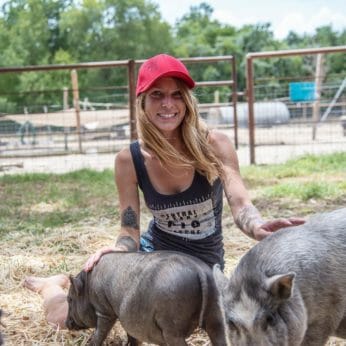
Brittany Illescas with some of the older piglets at CTPR. Photos by Brittany & Dan Illescas/Central Texas Pig Rescue
MF: How does vegetarianism factor into your mission?
Brittany: Dan and I are both vegan, but just like for many people who stop eating meat it was a slow progression and journey: we started eating only humanely-raised “One Bad Day” meat from farmers we knew and it went from there, but we try not to focus too much on that aspect of our lives. We try not to have a strictly vegetarian message because we work with a lot of pig parents, and if you’re too stringent then you’re going to lose people and then they’re not going to get the education they need. We work with a lot of different kinds of owners and farmers, we stick to the facts, we try not to shame them, we tell them the pigs’ stories and what their previous owners’ expectations were of them, the economics of what happens as they grow. I’m not going to stop you from eating meat, but I will invite you out here to meet my pigs and put them in your circle of compassion.
For more pig education, behavioral and veterinary advice and resources, and a constant stream of adorable farm animal photos and videos, follow Brittany, Dan, and Central Texas Pig Rescue on Instagram, Facebook, and YouTube. If you’d like to join CTPR in their “pig positive” educational and advocacy mission with a monetary donation, you can join their Patreon campaign for as little as $1 per month. You may even luck out with an original piece of snout art, painted by the pigs themselves, or a Hooters for Snooters pin-up calendar.
I’m looking for somebody to come to our home in Bastrop, tx and trip our pigs hooves. Do you know who can help us? We can’t get Rosco in the truck and it’s taking me too long to file them. Thank you Jennifer
Can i buy a pig?
Hello my name is Veda and I’m trying to help my son who has a pot belly pig Wilbur who is neutered and a small female pig named Penny he got them for his wife and 4 months after being married she packed her bags and left he also has chickens and a rooster and 2 ducks on 1/2 an acre and works as an electrician full time and doesn’t have enough time or space for all of them if you think you could accept the pigs as a rescue we can bring them to you please let me know… Read more »
My son has a pet pig that he can’t keep. He is lising his home and needs to find a good home for this pig. Can you help us?
I have one pig I found and he lives in a pen, he eats well so he is about 100lbs I guess. I would like to get him neutered . But no vets do home visits and I would like to get him a friend but like I said one will have to be fixed. I don’t want babies. But I would love to adopt him a friend so he doesnt live alone. He has a duck that visits him, in fact the duck found him for me. So if you can help me get him busters or help me… Read more »